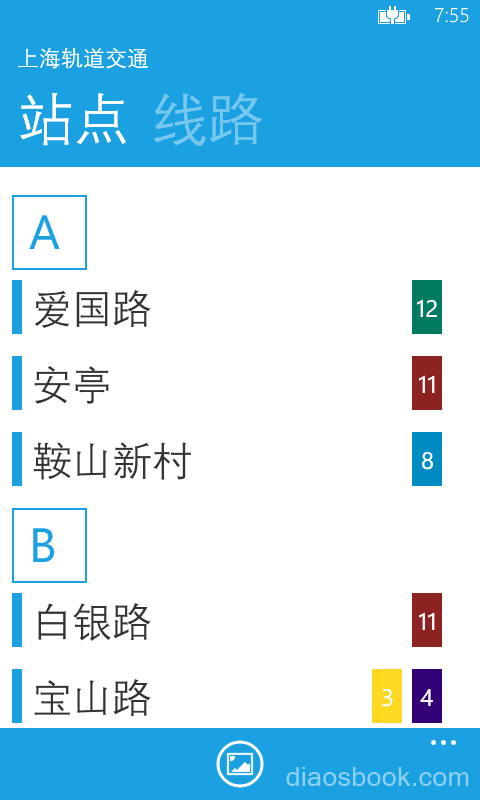Windows Phone 8的LongListSelector控件按拼音分组主要有两种方法,一个是在数据源里手工指定拼音首字母字段,作为index,这种方法效率高但会造成数据冗余不宜维护。另一个就是我今天介绍的方法,来自MSDN,虽然官网例子是针对是英文数据的首字母分组,但其实稍微改一下还是是支持中文的。
首先给大家看看分组的效果,和WP人脉应用按联系人拼音首字母分组的意思是一样的:

实现方法很简单。首先你需要一个来自MSDN的AlphaKeyGroup类,代码如下(我稍作了代码风格上的改动,编译结果和MSDN官网是一样的,不要在意这些细节):
public class AlphaKeyGroup<T> : List<T>
{
/// <summary>
/// The delegate that is used to get the key information.
/// </summary>
/// <param name="item">An object of type T</param>
/// <returns>The key value to use for this object</returns>
public delegate string GetKeyDelegate(T item);
/// <summary>
/// The Key of this group.
/// </summary>
public string Key { get; private set; }
/// <summary>
/// Public constructor.
/// </summary>
/// <param name="key">The key for this group.</param>
public AlphaKeyGroup(string key)
{
Key = key;
}
/// <summary>
/// Create a list of AlphaGroup<T> with keys set by a SortedLocaleGrouping.
/// </summary>
/// <param name="slg">The </param>
/// <returns>Theitems source for a LongListSelector</returns>
private static List<AlphaKeyGroup<T>> CreateGroups(SortedLocaleGrouping slg)
{
return slg.GroupDisplayNames.Select(key => new AlphaKeyGroup<T>(key)).ToList();
}
/// <summary>
/// Create a list of AlphaGroup<T> with keys set by a SortedLocaleGrouping.
/// </summary>
/// <param name="items">The items to place in the groups.</param>
/// <param name="ci">The CultureInfo to group and sort by.</param>
/// <param name="getKey">A delegate to get the key from an item.</param>
/// <param name="sort">Will sort the data if true.</param>
/// <returns>An items source for a LongListSelector</returns>
public static List<AlphaKeyGroup<T>> CreateGroups(IEnumerable<T> items, CultureInfo ci, GetKeyDelegate getKey, bool sort)
{
var slg = new SortedLocaleGrouping(ci);
var list = CreateGroups(slg);
foreach (var item in items)
{
var index = 0;
if (slg.SupportsPhonetics)
{
//check if your database has yomi string for item
//if it does not, then do you want to generate Yomi or ask the user for this item.
//index = slg.GetGroupIndex(getKey(Yomiof(item)));
}
else
{
index = slg.GetGroupIndex(getKey(item));
}
if (index >= 0 && index < list.Count)
{
list[index].Add(item);
}
}
if (!sort) return list;
foreach (var group in list)
{
@group.Sort((c0, c1) => ci.CompareInfo.Compare(getKey(c0), getKey(c1)));
}
return list;
}
}
这个类里面主要的精髓就在于:
var slg = new SortedLocaleGrouping(ci);
SortedLocaleGrouping可以根据传入的传入的CultureInfo返回经过排序的组标头。
要按照拼音首字母排序,我们只要传入中国大陆的CultureInfo就可以了,也就是zh-CN。在中文环境的Windows Phone系统上,当然也可以用当前UI线程的CultureInfo去获得
System.Threading.Thread.CurrentThread.CurrentUICulture
但是为了保证我们的拼音排序能在任何语言设置下都统一,我还是建议写死zh-CN在里面。
在我的应用里,我需要按地铁站点(Station类)的地铁站名首字母(Station.StationName)分组,所以我绑定的集合要用AlphaKeyGroup包一下:
public ObservableCollection<AlphaKeyGroup<Station>> GroupedStations { ... }
然后,在给这个集合赋值的地方写Group的具体逻辑:
GroupedStations = AlphaKeyGroup<Station>.CreateGroups(
AllStations,
new CultureInfo("zh-CN"),
s => s.StationName.Substring(0, 1),
true).ToObservableCollection();
第一个参数AllStations是原始数据,一个普通的IEnumerable<Station>集合。
第二个参数是最重要的,按哪种Culture进行分组,一定要传入zh-CN,简体中文。
第三个参数是个lambda表达式,这个委托负责分组字段的具体逻辑,在这里我们要按Station.StationName的第一个字的拼音首字母排序,所以需要取Substring(0,1),返回Station.StationName的第一个字,之后SortedLocaleGrouping就可以自动进行拼音首字母分组了。
第四个参数表示经过分组的排序结果需不需要排序,true表示需要排序,这也是我们通常的需求。
至此,后端代码的工作就全部搞定了。前台xaml上的数据绑定还是和普通的LongListSelector没啥区别。
XAML:
<phone:LongListSelector
x:Name="StationListSelector"
ItemsSource="{Binding GroupedStations, Mode=TwoWay}"
JumpListStyle="{StaticResource StationListJumpListStyle}"
IsGroupingEnabled="True"
HideEmptyGroups="True"
SelectionChanged="SelectStation"
toolkit:TiltEffect.IsTiltEnabled="True">
<phone:LongListSelector.GroupHeaderTemplate>
<DataTemplate>
<Border
BorderBrush="{StaticResource PhoneAccentBrush}"
Padding="15,0"
Width="75"
Height="75"
Margin="0,0,0,10"
BorderThickness="2"
HorizontalAlignment="Left"
Background="White">
<TextBlock Text="{Binding Key}"
FontSize="48"
Foreground="{StaticResource PhoneAccentBrush}">
</TextBlock>
</Border>
</DataTemplate>
</phone:LongListSelector.GroupHeaderTemplate>
....
App.xaml里的Style:
<Style x:Key="StationListJumpListStyle" TargetType="phone:LongListSelector">
<Setter Property="GridCellSize" Value="113,113"/>
<Setter Property="LayoutMode" Value="Grid" />
<Setter Property="ItemTemplate">
<Setter.Value>
<DataTemplate>
<Border Background="{StaticResource PhoneAccentBrush}" Width="113" Height="113" Margin="6" >
<TextBlock Text="{Binding Key}" FontFamily="{StaticResource PhoneFontFamilySemiBold}" FontSize="48" Padding="6"
Foreground="{StaticResource PhoneForegroundBrush}" VerticalAlignment="Center"/>
</Border>
</DataTemplate>
</Setter.Value>
</Setter>
</Style>
能盈利么?
虽然我是新手,但是我还是看懂了,帮助很大。